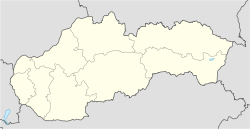|
Veličná
Veličná (Hungarian: Nagyfalu) is a village and municipality in Dolný Kubín District in the Žilina Region of northern Slovakia. NameVeličná was first mentioned under the Latin name Magna Villa in a decree of Ladislaus IV of Hungary from 1272. In the middle ages, the town was known also under the name Welkeg Wsy (Veľké Vsy, The Big Village) and the Hungarized forms Nag Flaw and Naghffalva. HistoryThe settlement grew in a relatively sparsely populated borderland area on an important trade route to Poland. By 1454, Veličná was already a smaller town. The town acquired several royal privileges (especially the privilege to trade with Polish salt) that positively influenced its economic development. By 1520, the town had become influential enough to become the seat of Orava County. In the 16th century, the region suffered several uprisings, which led George Thurzo to grant its citizens additional privileges to improve the economic situation. In 1683, the town was sacked by Lithuanian troops led by Jan Kazimierz Sapieha the Younger en route to the Battle of Vienna.[5] The casualties from this sacking included Veličná's town and county archive. The seat of the county was moved to Dolný Kubín; Veličná was burned again (twice) in 1686 and never fully recovered. The population decreased again during plague outbreaks in 1732, 1739, and 1742. In 1871, the town lost its status and became a village. Before the establishment of independent Czechoslovakia in 1918, Veličná was part of Árva County within the Kingdom of Hungary. From 1939 to 1945, it was part of the Slovak Republic. GeographyThe municipality lies at an altitude of 462 metres and covers an area of 29.302 km². It has a population of about 1300 people. The biggest part of the village is called Revišné. References
External links
|
||||||||||||||||||||||||||||||||||||

